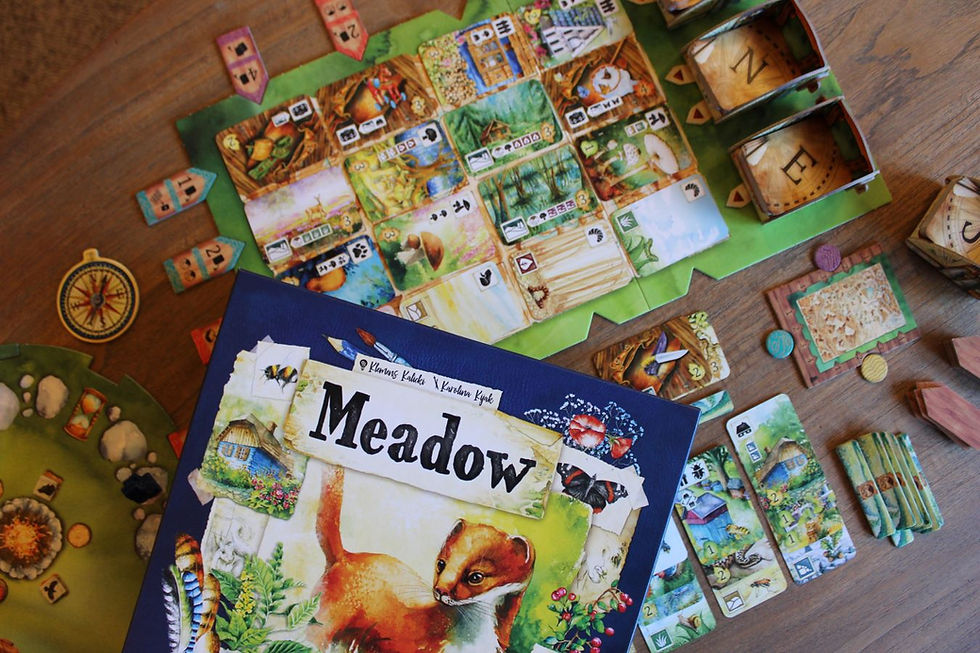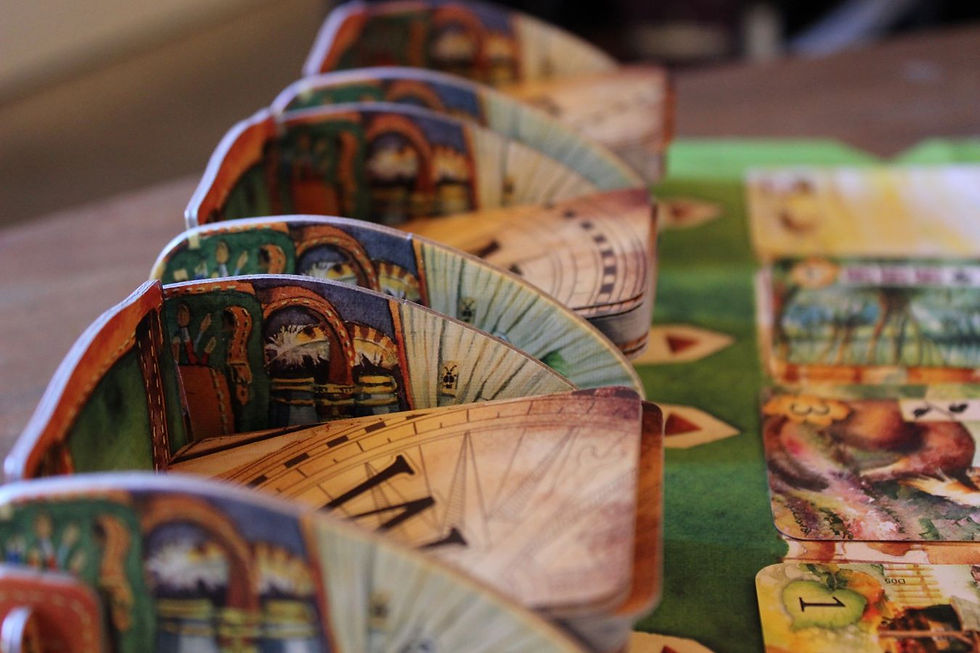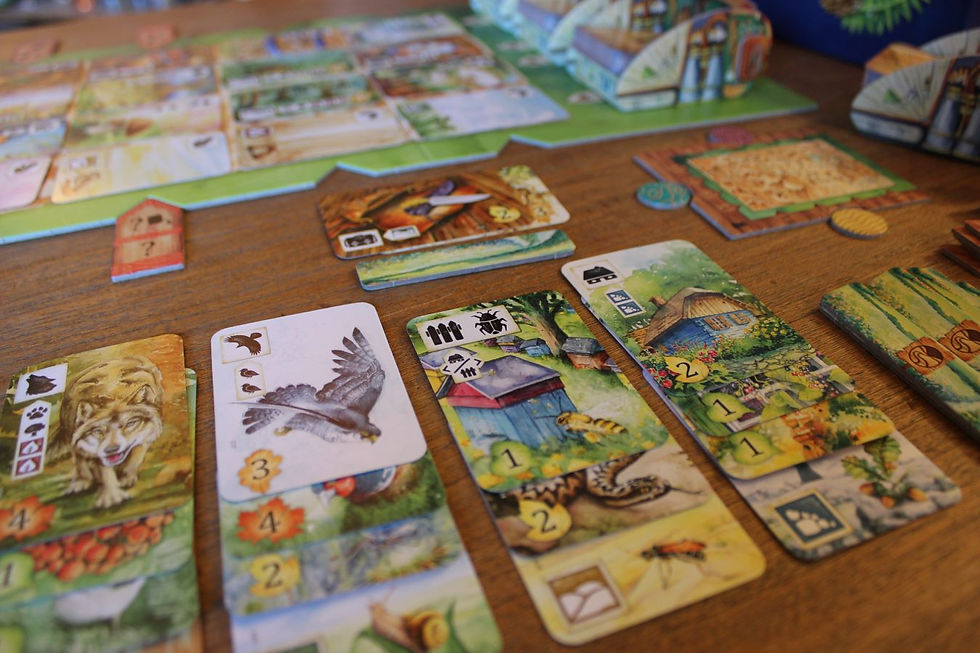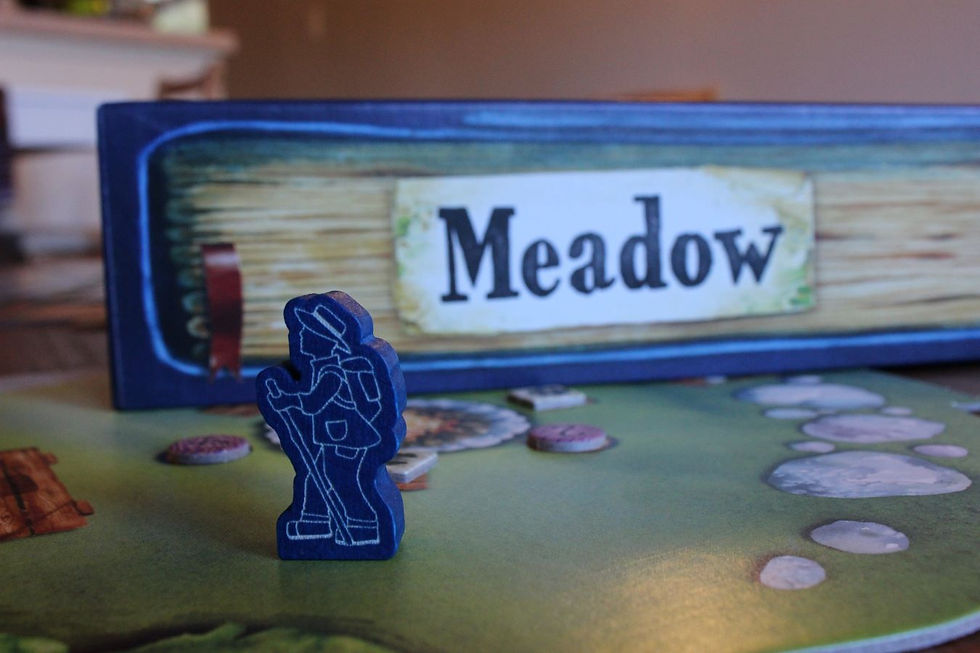Meadow - Review
- Solitary Quest Blog

- Nov 29, 2023
- 7 min read
Updated: Jan 12, 2024
Designer: Klemens Kalicki
Artist: Karolina Kijak
Publisher: Rebel Studio
Player Count: 1 to 4 Players
Play Time: 60 to 90 Minutes
Immerse yourself in the tranquil sights of nature. Wander and release in the calmness and beauty of the world. In this review of Meadow, I discuss what makes a game "cozy" and explain why this game may be better suited to higher player counts.

The Gist: Wander and Observe
Have you ever wanted to score points just for finding neat things outside? In Meadow players are wanderers, jaunting through nature taking account of the places they are visiting and the animals and objects they encounter. Collecting cards from a central board and playing them into their meadow, players build a tableau of all the interesting things they see while walking the countryside. Players earn points the more cards they collect and the more stories of their exploits they share around the campfire.
Gameplay: Collect from the Ground Up
Meadow is a card drafting and tableau building game in which players are taking turns selecting cards and playing them into their play areas. The shared card pool from which each player may draft cards is separated into four rows replenished by different decks—West, East, and two rows from the South deck. A fourth deck, North, replaces the South deck halfway through the game. Each deck primarily contains different card types, ensuring that there are always diverse card options on the main board for players to choose from. There will always be 16 cards from which players may choose.


On their turns, players take one of their five path tokens and place it on an open space on either the main board or the campfire board. Played to the main board, the token allows the player to take the card in the row it was placed in a number of spaces onto the board equal to the number on the token. The player can then play one card from their hand to their meadow, as long as the card’s suit requirements are met by cards already in the meadow. The resulting tableau of different card types—ground, observation, landscape, and discovery—form the unique ecosystem observed by that player. By picking up and playing cards with different symbols, players will expand the diversity of card suits in their meadow, allowing them to ramp-up towards playing cards with more complex suit requirements and higher point values.
Played to the campfire board, path tokens allow players to take the special action specified on each unique path token. Special actions can help replenish a players’ dwindling hand or acquire more road tokens which are part of the requirement cost of certain cards. Playing a path token to the campfire spot also lets players score additional points if they have symbols showing in their meadow that match pairs of bonus tokens around the campfire board that are determined before the game. So while most of the time players use their turns to play path tokens to the board in order to take and play cards, sometimes a timely path token on the campfire board can result in a quick point boost or jumpstart a stagnant tableau.
A game of Meadow lasts a number of rounds depending on the player count, tracked by the iconic Wanderer meeple trekking around the campfire board. At the end of the game, players tally points scored in their meadow and from objectives scored on the campfire board. The highest score wins.

Solo: Rover
Meadow boasts a solo variant where the player is up against an automa named Rover. Just like the player, Rover relies on the path tokens to determine what action he will take each turn. The player shuffles all the unused path tokens from the other colors into a facedown pile. On Rover’s turn, the player draws one path token randomly from the pile and plays it to the corresponding, color-matched notch on the game board, helpfully guided by the solo play game token. Rover takes a card to his pile just like any player would. Wildcard path tokens are placed into an empty notch in the campfire board but do not grant Rover any additional boons.
Rover will always go first, but otherwise does not benefit from any other bonuses, like access to bonus tokens. Instead of manicuring his own meadow, all of Rover’s cards end up in a single stack that is tallied at the end of the game and compared to the point total of the player. If the player scores higher than Rover, they proceed to check their score on the solo scoring table that will tell them whether “(they) were distracted” or “(their) collection is worth displaying.”

Thoughts: Light Equals Cozy?
Meadow is frequently described as one of the top cozy board games, like in this article from GamesHub or this episode of Shut Up & Sit Down. I can see why. The artwork puts the tranquility of nature on full display, featuring brilliant scenes of rural landscapes and an exhibition of creatures from mere worms to apex predators. Karolina Kijak’s watercolors invite the players into the gentle scenes. Similarly, the concept of the game lends Meadow a more comforting feel. It is a nature game not about collecting, harvesting, or manipulating nature. Players are not destroying anything, hunting or killing, capturing wildlife or settling ecosystems. They are just observing, going for a walk.
And the coziness of the game is not just reflected in its artwork, but is conveyed in the gameplay as well. Meadow is a light strategy game that will not demand a great deal of cross referencing the rulebook. Taking a turn is as simple as choosing which notch to place a path token to. The narrow selection of potential play options each turn means the strategy of Meadow is in the selection of which card to take, and which one to play rather than the complexity of the gameplay itself. This means that the game should be rather quick to learn, and not too cerebral.

But those two elements—theme and gameplay—have a somewhat flat connection to one another. Although the concept of trekking through tranquil nature is well-conveyed in the artwork and component design, the mechanics of the game are not really influenced by the theme. During gameplay, it was simpler to look past the theme to focus on the symbols I needed to acquire rather than attending to the brilliant landscapes and wildlife depicted on the cards. The turn action and format of the tableau players are building would have worked just as well if they were reskinned for an outer space exploration game, for instance, with players traveling to and seeing different planets, the nature symbols replaced by galaxy symbols, and the campfire board replaced by a spaceship board. Once you start playing, the nature theme just feels like a beautiful coat of paint splattered on to a totally independent game engine configuration.
This is not to say that that game engine is not remarkable; Meadow features some very intelligent mechanics balancing the gameplay. For instance, the two scoring avenues—the tableau and campfire board bonuses—are well weighted against one another given how often each is played to, and scoring generally is not too swingy. The use of four separate decks, each with their own distribution of card types and symbols, to fuel the shared card pool ensures a plentiful availability of card types and symbols to all players and prevents players from successfully pursuing an annoying strategy of choking resources. The deck rotation halfway through the game also adds some pacing to the game, and makes setting up a diverse tableau of card symbols before the late game (where cards require a lot more visible symbols to play) critical to scoring a lot of points in the meadow. And players can interact with one another and thwart opponents’ strategies by blocking key notches on the main board and campfire board without this being a “gotchya” kind of game.
Thoughts: Is Solo Play Too Easy?
In my last review of Expeditions from Stonemaier Games, I wrote about the importance of variability in solo variant automas. Facing a mechanized opponent, solitary gamers should have some say in how difficult the game ought to be, whether they are looking for an easy win or a near impossible challenge. Variability in a solo variant automa is a huge reason why gamers will return to a game time and again, to experience new and increasingly difficult challenges. Meadow’s automa does not have a variable difficulty setting and unfortunately Rover is just way too easy to beat every time.
The solo player and Rover will encounter approximately the same number of cards throughout the game and while the player has the added task of arranging a functional tableau, all the cards Rover acquires go right into a stack to be scored at the end of the game. But the player has a significant advantage over Rover in that they can make intelligent decisions based on the current board state, selecting higher valued cards and taking special actions to increase their card pool and the number of cards they can play to the meadow. All of Rover’s selections, however, are random. This means he’s not going to be selecting the cards that will have the greatest point scoring return. For example, Rover will continuously pick up ground cards that score no points, even in the late game when the player is capable of playing more complex and higher value cards almost every turn. Because they are more or less drawing the same number of cards, this presents a significant scoring advantage to the player. And with access to campfire board bonuses that Rover cannot utilize, the player should usually have no trouble ending the game with a higher score than the automa.
Unfortunately this renders Rover a somewhat idle participant in the solo game. And since the placement of his path tokens is fixed by the solo play game token, he also cannot strategically block the player from taking a decisive action by placing a path token in an ideal spot. This can make it feel like the player is just going through the motions of playing the game, taking what cards they are given in the drafting area to try to beat their own high score. Without a scalable difficulty or options for new challenges, there is not much seducing a solo player to come back for more.

Final Thoughts: A 2-Player Staple
A lot of games that are considered cozy and comforting aim to immerse the players into the theme and world of the game, providing an outlet from the fraught real world. This is a classic form of escapism that is at the center of many board games. Immersion in Meadow is encouraged with light play, vibrant art, and a coherent message that nature, including its beautiful landscapes and diverse wildlife, is something to be appreciated, enjoyed in conservation and respect. But once the game begins, that immersion seems abstract from the gameplay itself.
Meadow is a very enjoyable multiplayer game, and is balanced especially well at two players. This is ideal for a quiet evening; light a candle, open a window and let in the sounds of nature. You don’t even have to leave your home to wander the wilderness and see something beautiful.





Wonderful review! thank you!